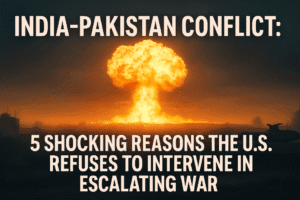India-Pakistan Conflict: 5 Shocking Reasons the U.S. Refuses to Intervene in Escalating War
Amid escalating military tensions between India and Pakistan, U.S. Vice President JD Vance emphasized a policy of non-intervention, stating the conflict is “none of our business.” The crisis began with India’s Operation Sindoor, targeting Pakistani terror camps after a deadly April attack, prompting retaliatory strikes from Pakistan. While the U.S. urged diplomatic de-escalation, Vance ruled out direct involvement, marking a shift from America’s historical role as mediator in South Asian disputes.
Analysts note concerns over regional stability, particularly nuclear risks, as clashes persist. Global powers like China and Russia remain muted, signaling fragmented diplomacy. The U.S. stance reflects lessons from past foreign entanglements but raises questions about power vacuums and unchecked escalation. With civilian casualties mounting, the conflict tests both nations’ resolve and the international community’s capacity to mitigate crisis without traditional U.S. leadership.

India-Pakistan Conflict: 5 Shocking Reasons the U.S. Refuses to Intervene in Escalating War
In a striking departure from historical precedent, U.S. Vice President JD Vance declared that America would refrain from direct involvement in the intensifying military conflict between India and Pakistan, emphasizing that the war is “fundamentally none of our business.” Speaking to Fox News on May 9, 2025, Vance underscored Washington’s intent to prioritize diplomatic encouragement for de-escalation over intervention, marking a potential shift in U.S. foreign policy toward South Asia.
The Catalyst: Operation Sindoor and Retaliatory Strikes
Tensions flared after India launched Operation Sindoor on May 7, a targeted military campaign aimed at dismantling terror camps in Pakistan following the devastating April 22 Pahalgam attack, which killed over 50 Indian security personnel. While India asserted the operation avoided civilian and military sites, Pakistan retaliated with missile and drone strikes on 15 Indian cities, including Jammu & Kashmir, Punjab, and Rajasthan. India’s defense systems intercepted most projectiles, but the conflict escalated further as Indian forces reportedly neutralized Pakistan’s air defenses in Lahore.
Vance’s Pragmatic Approach
Vance’s remarks reflect a pragmatic, restrained U.S. stance:
- Diplomatic Channels Over Intervention: “We may encourage de-escalation, but we won’t insert ourselves into a war we can’t control,” Vance stated, ruling out demands for either nation to “lay down arms.”
- Nuclear Concerns: Acknowledging fears of nuclear escalation, he added, “Our hope is this doesn’t spiral into a broader regional war.”
Historical Context: A Departure from Past U.S. Postures
The U.S. has historically mediated India-Pakistan conflicts, such as during the 1999 Kargil War and the 2008 Mumbai attacks. Vance’s hands-off approach aligns with growing domestic skepticism toward foreign entanglements but risks ceding diplomatic influence to powers like China or Russia, both of whom have vested interests in the region.
Regional Implications and Global Reactions
- Humanitarian Toll: Civilian casualties mount as cross-border strikes disrupt daily life. Yet, neither side has addressed humanitarian crises publicly.
- Silent Global Players: China, Pakistan’s ally, has urged restraint but avoided condemnation. Russia, India’s strategic partner, remains conspicuously quiet.
- Nuclear Shadow: Analysts warn that unchecked escalation could revive dormant nuclear postures, with both nations possessing arsenals since 1998.
Expert Insights: A Calculated Risk?
Foreign policy analysts suggest Vance’s stance may reflect lessons from Afghanistan and Ukraine, where U.S. involvement yielded protracted conflicts. “Non-intervention could pressure India and Pakistan to negotiate, but it also gambles with regional stability,” says Dr. Anjali Rao of the Brookings Institution. Others argue that without U.S. mediation, escalation becomes likelier.
The Road Ahead
As clashes persist, questions linger:
- Will third-party mediators like the UAE or Saudi Arabia step in?
- Could economic sanctions or UN resolutions emerge if violence spreads?
- How will India’s upcoming elections and Pakistan’s fragile government impact decisions?
For now, the Biden-Vance administration’s strategy hinges on cautious diplomacy, betting that regional actors will prioritize stability over prolonged conflict. Yet, as history shows, in South Asia’s volatile landscape, even calculated risks carry unforeseen consequences.
You must be logged in to post a comment.